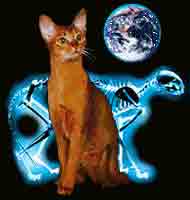If there are intelligent life in different universes, there is a possibility that they have technology that allows them to move from their space/time to another space/time, including the one in which we live

Illustration: Schrödinger's cat. Alive or dead?
In 1803, the physicist Thomas Young performed an experiment that was a breakthrough in the study of light and at the same time was the first stage in the development of quantum theory at the beginning of the 20th century. In this experiment, a beam of light was sent towards two tiny holes next to each other that were drilled in a board and when the light came out of them and was projected onto a nearby background A phenomenon of destructive interference and constructive interference was distinguished, as if the board did not exist.
In an attempt to deal with this phenomenon in an unusual way, we will accept as an assumption that indeed part of the light did pass through the nozzles as it was indeed observed and another part of the light passed through the panel itself. The question that can rightly be asked, is it possible? For this we will use two basic laws and they are the law of conservation of matter which is also the law of conservation of energy and the law of energy conservation. The law of conservation of matter and energy says that matter or energy does not disappear, but takes form and loses form. The law of energy conservation means that every natural process is carried out using minimal energy. An example that can illustrate this nicely is a river. The course of a river never moves in a straight line.
The water in its movement plows through the rock as long as it can overcome the hardness of a rocky barrier in the direction of its flow. When they come across a rock that withstands their strength, they will turn towards a less hard rock that they can hit, crumble and melt. The end result is a tortuous flow path.
In analogy to the river, we will accept as an assumption that that part of the light that does not pass through the nozzles, converts itself into another phase that allows it to overcome this obstacle. That phase is nothing but another dimension for which the board does not exist at all.
Going beyond this phase allows the use of less energy. From the moment that the light in this phase passed the plate, it returned to the familiar phase, to those dimensions observed both by the human eye and by the instruments built to track it.
From the moment the light hit the plate it joined the part that hit the background and then the destructive interference and the constructive interference were received.
Can this assumption be valid according to quantum theory? A key concept developed by Niels Bohr is complementarity according to which "different descriptions of reality that would contradict each other if they were applied together, can all be valid if each is applied only in its experimental context" (Ben Dov 1997: 273). From the point of view of the human eye or the tracking devices that man develops, the photons (particles of light) at one moment exist and at another moment do not exist. Their existence as it is perceived cognitively is possible only in the space/time in which the person exists. According to the assumption we presented, the photons continue to exist in this dimension and perhaps in other dimensions. Hence, according to this logic, different descriptions of the photons in different dimensions are possible, each of which is valid in its space of operation and actually complement each other. We then learned that complementarity is a universal phenomenon in any dimension or other dimensions.
If we continue with this line of thought, the conclusion that follows is that there are more than four dimensions. Among physicists who focus on researching the possibility of the existence of additional dimensions, the accepted assumption today is that a total of 10 dimensions exist, although there are theories that talk about a larger number of dimensions. Therefore, according to the line of thought presented here, in any combination of dimensions, different applications can exist and each has its own validity. In any combination of dimensions, quantum theory has physical validity and photons will move to other dimensions for reasons of saving energy and return to their natural dimensions of existence, while not It will be necessary to overcome a barrier such as the one mentioned at the beginning of the discussion.
If we go one step further and assume that there are intelligent life in different universes, there is a possibility that they have a technology that allows them to move proactively from their space/time to another space/time, including the one we live in and Schrödinger's cat comes to life.
מקור
Yoav Ben Dov - Quantum Theory, Dvir Publishing House, 1997
